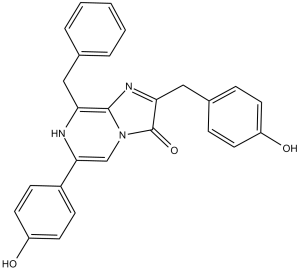This product is for research use only, not for human use. We do not sell to patients.

| Size | Price | Stock |
|---|---|---|
| 100mg | $1750 | Check With Us |
| 200mg | $2625 | Check With Us |
| 500mg | $4425 | Check With Us |
Cat #: V1873 CAS #: 55779-48-1 Purity ≥ 98%
Description: Coelenterazine, a luciferin which is a light-emitting molecule, is a luminescent enzyme substrate that is used for monitoring reporter genes in BRET, ELISA and HTS techniques.
References: Markova SV, et al, Coelenterazine-dependent luciferases. Biochemistry (Mosc). 2015 Jun;80(6):714-32.
Publications Citing InvivoChem Products
Product Promise

- Physicochemical and Storage Information
- Protocol
- Related Biological Data
- Stock Solution Preparation
- Quality Control Documentation
| Molecular Weight (MW) | 423.46 |
|---|---|
| Molecular Formula | C26H21N3O3 |
| CAS No. | 55779-48-1 |
| Storage | -20℃ for 3 years in powder formr |
| -80℃ for 2 years in solvent | |
| Solubility In Vitro | DMSO: 84 mg/mL (198.4 mM)r |
| Water: <1 mg/mLr | |
| Ethanol: <1 mg/mL | |
| SMILES Code | C1=CC=C(C=C1)CC2=C3N=C(C(=O)N3C=C(N2)C4=CC=C(C=C4)O)CC5=CC=C(C=C5)O |
| Synonyms | Oplophorus, luciferin; Coelenterazine; CLZN |
| Protocol | In Vitro | HCT-8 control cells, transiently expressing Renilla luciferase (RLuc), showed low bioluminescence due to P-glycoprotein–mediated efflux transport of coelenterazine. By comparison, transiently expressing RLuc HCT-8 cells, wherein P-glycoprotein was down-regulated with shRNAi, showed high bioluminescence. |
|---|---|---|
| In Vivo | The in vivo growth potential of HCC1806-RR was monitored by injecting animals with coelenterazine (2 mg/kg) i.v. and exposing them to a charged-coupled device (CCD) camera 5 minutes later. Rluc activity was detected as light emitted from the tumor cells and acquired as a pseudo-color image superimposed over a black and white photograph of the animal. All mice demonstrated very high Rluc activity at the primary site with the majority of mice simultaneously showing metastases to inguinal ILNs. |
| Solvent volume to be added | Mass (the weight of a compound) | |||
|---|---|---|---|---|
| Mother liquor concentration | 1mg | 5mg | 10mg | 20mg |
| 1mM | 2.3615 mL | 11.8075 mL | 23.6150 mL | 47.2300 mL |
| 5mM | 0.4723 mL | 2.3615 mL | 4.7230 mL | 9.4460 mL |
| 10mM | 0.2361 mL | 1.1807 mL | 2.3615 mL | 4.7230 mL |
| 20mM | 0.1181 mL | 0.5904 mL | 1.1807 mL | 2.3615 mL |
| Quality Control Documentation |
|
|---|
This equation is commonly abbreviated as: C1 V1 = C2 V2
- (1) Please be sure that the solution is clear before the addition of next solvent. Dissolution methods like vortex, ultrasound or warming and heat may be used to aid dissolving.
- (2) Be sure to add the solvent(s) in order.




































